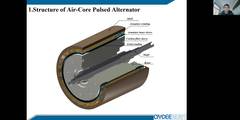Structural Design and Process Technology of a Seven-Phase Air-Core Pulsed Alternator
ID:273
Submission ID:184 View Protection:ATTENDEE
Updated Time:2021-12-03 10:55:51 Hits:795
Oral Presentation

Start Time:2021-12-17 09:15 (Asia/Shanghai)
Duration:15min
Session:[G] Electric Machine Design and Control » [G3] Session 29
Video
No Permission
Presentation File
Tips: The file permissions under this presentation are only for participants. You have not logged in yet and cannot view it temporarily.
Abstract
Abstract -- With the improvement of the energy and power requirements of the pulse power supply by the electromagnetic emission load, the air-core pulsed alternator gradually replaces the iron-core compensated pulse generator as the mainstream in the research field. The air-core pulsed alternator system based on inertial energy storage has large energy storage density, which integrates energy storage, electromechanical energy conversion and pulse shaping. Since the working mode of the air-core pulsed alternator is different from that of the conventional iron-core motor, its structure and design method are also different. Based on a seven-phase air-core pulsed alternator with 50MJ energy storage, this paper presents the design method and process technology of the key components of the alternator. On the stator side, the armature winding must use the Litz wire structure to reduce the loss of pulse current. The design method of Litz wire is presented. The armature winding withstands large Lorentz force during discharge, so the fixing structure should be strictly designed. The analytical formula of Lorentz force is derived and the special fixing structure of armature winding is also presented. On the rotor side, the stress and deformation of rotor basal body during high speed rotation are analyzed by 3-D finite element calculation, and the selection principle of rotor size is given. Moreover, the design principle of carbon fiber sleeve is given and the reliability of the design is verified by 3-D finite element simulation.Abstract -- With the improvement of the energy and power requirements of the pulse power supply by the electromagnetic emission load, the air-core pulsed alternator gradually replaces the iron-core compensated pulse generator as the mainstream in the research field. The air-core pulsed alternator system based on inertial energy storage has large energy storage density, which integrates energy storage, electromechanical energy conversion and pulse shaping. Since the working mode of the air-core pulsed alternator is different from that of the conventional iron-core motor, its structure and design method are also different. Based on a seven-phase air-core pulsed alternator with 50MJ energy storage, this paper presents the design method and process technology of the key components of the alternator. On the stator side, the armature winding must use the Litz wire structure to reduce the loss of pulse current. The design method of Litz wire is presented. The armature winding withstands large Lorentz force during discharge, so the fixing structure should be strictly designed. The analytical formula of Lorentz force is derived and the special fixing structure of armature winding is also presented. On the rotor side, the stress and deformation of rotor basal body during high speed rotation are analyzed by 3-D finite element calculation, and the selection principle of rotor size is given. Moreover, the design principle of carbon fiber sleeve is given and the reliability of the design is verified by 3-D finite element simulation.
Keywords
air-core pulsed alternator, structural design, process technology, mechanical strength.
Speaker




Comment submit